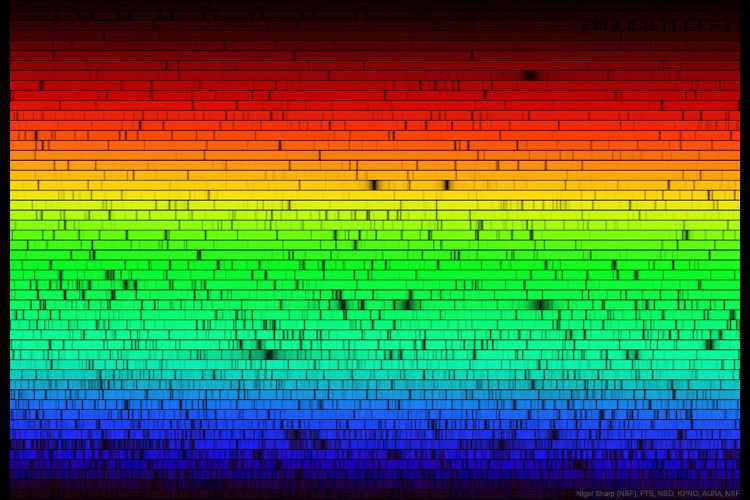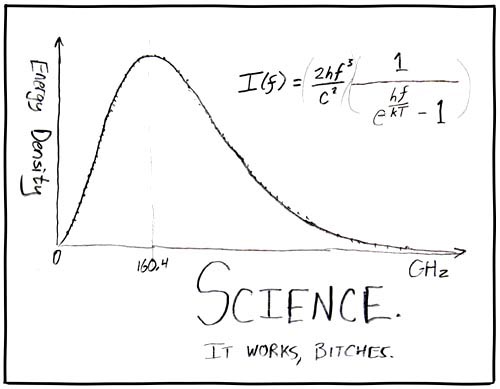On this date a whopping 60 years ago, there came an accidental discovery that helped confirm, and inform, our present view of the universe: the cosmic microwave background (CMB) was first measured.
Here’s the quick run down. Observations of many stars in the observable universe, generally around the early 1900s, showed light spectra that were very similar to our own sun, with gaps in certain wavelengths that likely came from wavelength absorption by certain elements. These gaps were near-perfectly aligned, but shifted lower in wavelength consistently – some by small increments, others by larger, still with the same spacing between gaps. As an object accelerates away from us, the wavelengths get longer and thus more red, which nicely explained this shift (called redshift or doppler shift – it happens with sound as well, but of course in pitch and not color.) The thing was, every star so measured displayed this redshift, meaning that either they were all accelerating away from us, which has no reasonable impetus, or the universe was expanding uniformly, so everything got farther away from everything else, and the same redshift would be viewed from any planet around those other stars. This suggested that the universe was once in a much smaller state, and various other bits of evidence began to support this, but it had not yet become accepted as fact.

Image Credit: Nigel Sharp (NSF), FTS, NSO, KPNO, AURA, NSF
One line of reasoning suggested that, given all of the measurements of speed and distance and even radiometric decay, the universe began this acceleration between 10 and 20 billion years ago, and should have displayed some residual energy left over from this very small state, visible everywhere – except that it was so weak and so attenuated in wavelength that it was invisible and immeasurable with any radio telescope at the time.
[Brief explanation: electromagnetic radiation is defined by its wavelength, and between about 400 and 700 nanometers it becomes visible to our eyes, but on either side of that it’s invisible and is called ‘radio’ waves or ‘microwaves,’ and you see where this is going.]
That residual radiation was proposed for a few decades to pop up at certain wavelengths, but it was in 1948 that it was shown to likely exist in the microwave spectrum, at roughly 160 Ghz or 1.8 million nanometers (the science geeks are losing their minds right now but that’s how it compares to the visible light figures in the paragraph above) – also, extremely weakly. There was no way to detect this, so it remained theoretical.
Then in 1964, Robert Wilson and Arno Penzias were calibrating a new radio telescope and couldn’t achieve an empty baseline – in other words, they couldn’t clear the ‘static.’ After many attempts that retained a persistent reading at a certain wavelength, they made the connection with proposed efforts from physicists at Princeton University and contacted them, and it was soon determined that they’d found the CMB; bear in mind that the theoretical paper had been published 16 years earlier and wasn’t even part of college courses.
 What this meant, however, was that of the two main competing theories about the nature of the universe – the ‘big bang’ theory (itself originally a derogatory term) and the ‘steady state’ theory, almost the default assumption for centuries that the universe is as it always was and will be – the discovery of the CMB tipped the scales very much in favor of the Big Bang and put a distinct age to the universe. Just in my own lifetime, this age has gone from as stated above to 13.787 billion years (+/- 0.14%) due to refinements in measurements and technical abilities.
What this meant, however, was that of the two main competing theories about the nature of the universe – the ‘big bang’ theory (itself originally a derogatory term) and the ‘steady state’ theory, almost the default assumption for centuries that the universe is as it always was and will be – the discovery of the CMB tipped the scales very much in favor of the Big Bang and put a distinct age to the universe. Just in my own lifetime, this age has gone from as stated above to 13.787 billion years (+/- 0.14%) due to refinements in measurements and technical abilities.
Primarily, this is exactly the kind of confirmation that we look for when we make predictions, and while there still remains a level of uncertainty about both the numbers and the underlying process itself, any new theories have to take into account how well the CMB fits into the initial numbers; it’s there, it’s measurable, so something must have caused it. Moreover, one of the coolest and most impactful discoveries in modern astronomy was initially a source of significant frustration for Penzias and Wilson, who weren’t even trying to find it.
The radio antenna itself, long disused now, still sits where it was constructed, with plans to turn the area into a park and preserve the antenna itself. Which is good, because we have too few science-themed parks and too little recognition of those that made many of these accomplishments. Seriously, why should we give a shit about some sports figure?



















































